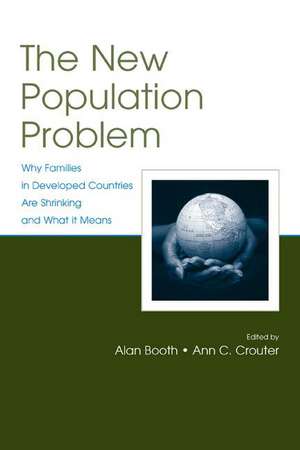The New Population Problem: Why Families in Developed Countries Are Shrinking and What It Means: Penn State University Family Issues Symposia Series
Editat de Alan Booth, Ann C. Crouteren Limba Engleză Paperback – 6 apr 2005
Divided into four Parts, the text:
*looks at contemporary trends in U.S. fertility, thus setting the stage for the entire volume;
*discusses social and cultural values and attitudes;
*analyzes fertility decisions in different countries; and
*focuses on the possible long-term consequences of current fertility trends for individuals, families, and societies.
Preț: 298.13 lei
Preț vechi: 399.26 lei
-25% Nou
Puncte Express: 447
Preț estimativ în valută:
57.05€ • 61.95$ • 47.93£
57.05€ • 61.95$ • 47.93£
Carte tipărită la comandă
Livrare economică 23 aprilie-07 mai
Preluare comenzi: 021 569.72.76
Specificații
ISBN-13: 9780805849790
ISBN-10: 0805849793
Pagini: 276
Dimensiuni: 152 x 229 x 15 mm
Greutate: 0.39 kg
Ediția:1
Editura: Taylor & Francis
Colecția Psychology Press
Seria Penn State University Family Issues Symposia Series
Locul publicării:Oxford, United Kingdom
ISBN-10: 0805849793
Pagini: 276
Dimensiuni: 152 x 229 x 15 mm
Greutate: 0.39 kg
Ediția:1
Editura: Taylor & Francis
Colecția Psychology Press
Seria Penn State University Family Issues Symposia Series
Locul publicării:Oxford, United Kingdom
Public țintă
ProfessionalCuprins
Contents: Preface. Part I: Contemporary Patterns and Trends in U.S. Fertility: Where Have We Come From, and Where Are We Headed? S.P. Morgan, K. Hagewen, Is Very Low Fertility Inevitable in America? Insights and Forecasts From an Integrative Model of Fertility. R.K. Raley, The Role Of Nonmarital Births in Sustaining Replacement Fertility in the United States. M.B. Tucker, When the Rule Applies: Commentary on "Is Very Low Fertility Inevitable in America?" S.M. Bianchi, Time and Money: Market Work, Nonmarket Work, Gender Equality, and Fertility. Part II: How Do Social and Cultural Values and Attitudes Shape Fertility Patterns in the Developed World? J.S. Barber, W.G. Axinn, How Do Attitudes Shape Childbearing in the United States? S. Lundberg, Childbearing Decisions: Can Attitude Measures Play a Role in Casual Modeling? H-P. Kohler, Attitudes and Low Fertility: Reflections Based on Danish Twin Data. D.F. Alwin, Attitudes, Beliefs, and Childbearing. Part III: How and Why Is Fertility Tied to Marriage--Or Not? E. Thompson, Partnerships and Parenthood: A Comparative View of Cohabitation, Marriage, and Childbearing. S. Jaffee, Partnership Stability and Marital Outcomes in a Representative UK Sample. H.B. Presser, The Importance of Gender Relations for Understanding Low Fertility and Single Motherhood. N.S. Landale, The Changing Partnership Context of Parenthood: Where Do Researchers Go From Here? Part IV: What Are the Long-Term Consequences of Current Fertility Trends for Individuals, Families, and Society. C. Bachrach, R. King, A. Yuan, Children as Private and Public Goods: Implications of Fertility Trends. L. White, Creating the Next Generation: Whose Responsibility? D.T. Lichter, J. Wooton, The Concentration of Reproduction in Low-Fertility Societies: The Case of the United States. Panel Discussion: W.G. Axinn, C. Bachrach, J.S. Barber, D. Lichter, S.P. Morgan, E. Thomson, L. White, The Future of Low Fertility. T. St. Pierre, J.K. Dariotis, Understanding Low Fertility: The Impact of Life-Course Competition on Fertility Behavior in Developed Nations.
Recenzii
"This volume would be of interest to all with an interest in changes affecting fertility and childbearing in developed countries."
—Australian Institute of Family Studies
—Australian Institute of Family Studies
Notă biografică
Alan Booth (Edited by) , Ann C. Crouter (Edited by)
Descriere
This volume focuses on the phenomenon of lower fertility rates occurring in the developed world. It explores the factors that influence couples' decisions on the number of children they will have and what are the long-term consequences of declining ferti







